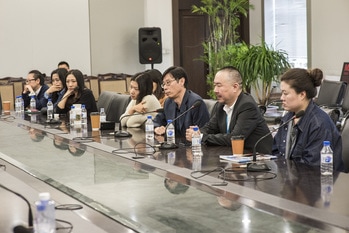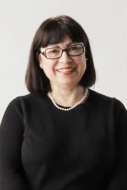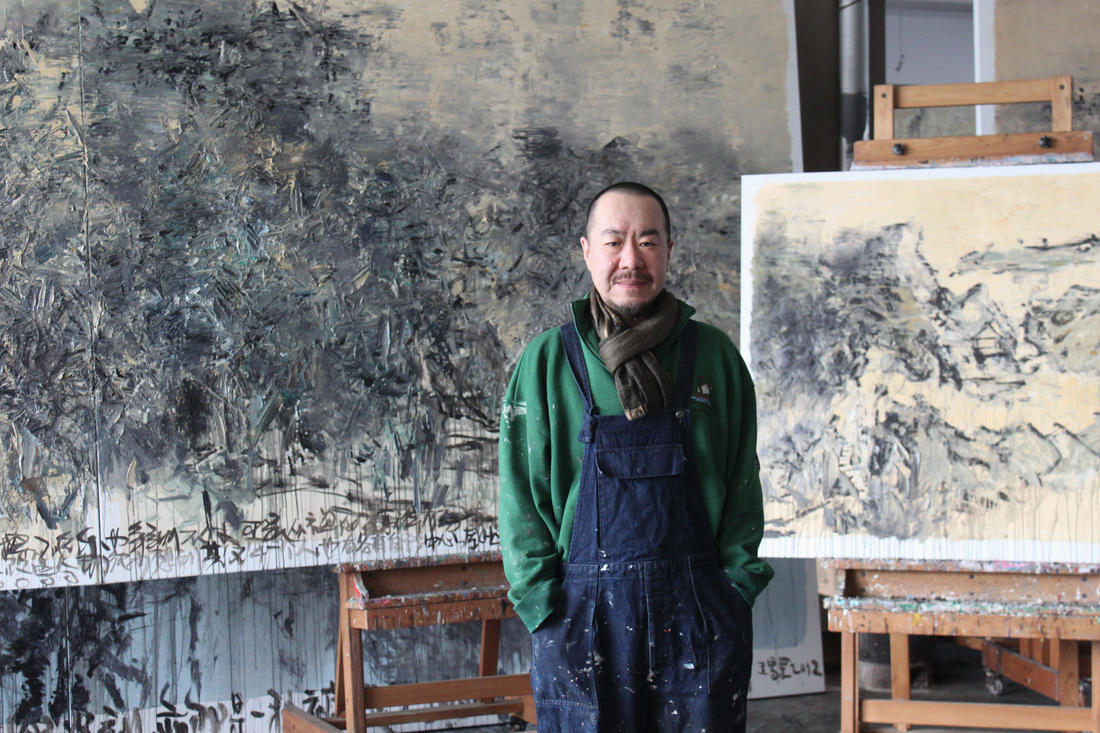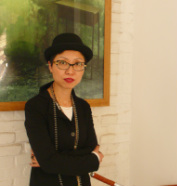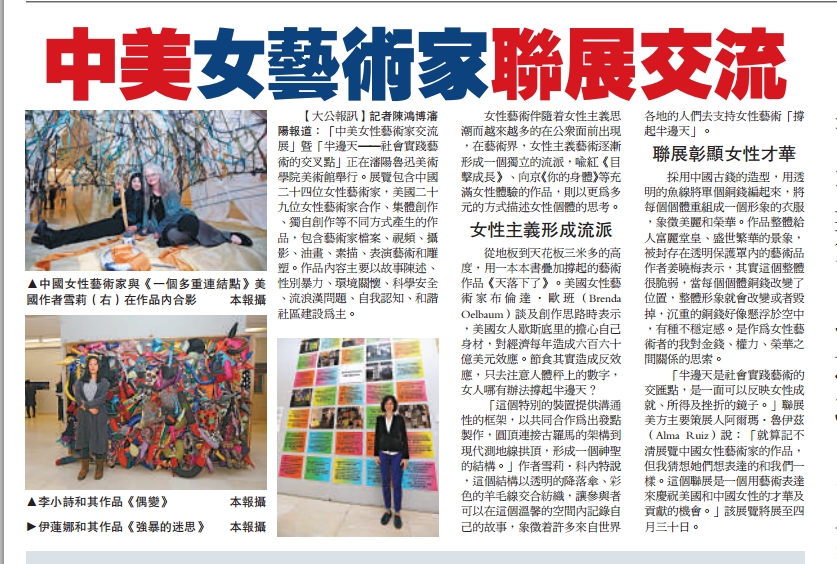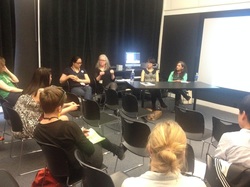Half the Sky: Intersections in Social Practice Art
Exhibition and Cultural Exchange for Women's Caucus for Art
Director: Sherri Cornett
LuXun Academy of Fine Arts, Shenyang, Liaoning Province, China
April 15 - 30, 2014
Exhibition and Cultural Exchange for Women's Caucus for Art
Director: Sherri Cornett
LuXun Academy of Fine Arts, Shenyang, Liaoning Province, China
April 15 - 30, 2014
|
Juried US-Based and Curated Chinese Art
|
Interactions
|

In March 2013, Wei Er Shen, President of LuXun Academy of Fine Arts in Shenyang, Liaoning Province, China invited the Women’s Caucus for Art (WCA) to create an art-based cultural exchange and exhibition between artists and essayists juried through WCA and women artists curated in China. He and the Gallery Director Wang Yi Gang were interested in providing an opportunity for Chinese women artists to interact with artists from our organization, to learn more about feminist art history in the west and share their art with our artists. As the Main Representative to the United Nations for and Director of the International Caucus of the Women's Caucus for Art, Sherri Cornett enthusiastically embraced this opportunity to direct this project and to further dialogue around women's issues within the framework of an exhibition. In addition to the exhibition, Half the Sky: Intersections of Social Practice Art included a sixteen-member delegation of selected WCA members, thirteen of whom, traveled to Shenyang for the opening of this exhibition and participated in three days of interactive events with the Chinese artists and students of the Academy. Over twenty-five volunteers from the U.S., working in teams, developed, prepped, installed, documented, publicized, fundraised, published, facilitated and traveled to create the many layers of this project.
Social practice art encompasses a wide range of art forms - public art, interactive media, performance, dialogue, activism, community practice, community building, interventions, and collaborations that cross art, public and social arenas. This project's cultural exchange was, in itself, a form of social practice form art. In the exhibition, artwork from our juried process and the curated Chinese artists created a powerful environment in which the delegation and Chinese women artists and students interacted in a variety of events - creation of collaborative art, dialogues, demonstrations, and and artists roundtable, all of which brought out surprising and intriguing information about both cultures, forming new bridges of understanding and support between US artists and artists in this conservative region of China.
Social practice art encompasses a wide range of art forms - public art, interactive media, performance, dialogue, activism, community practice, community building, interventions, and collaborations that cross art, public and social arenas. This project's cultural exchange was, in itself, a form of social practice form art. In the exhibition, artwork from our juried process and the curated Chinese artists created a powerful environment in which the delegation and Chinese women artists and students interacted in a variety of events - creation of collaborative art, dialogues, demonstrations, and and artists roundtable, all of which brought out surprising and intriguing information about both cultures, forming new bridges of understanding and support between US artists and artists in this conservative region of China.
|
Teaser Video
Half the Sky: Intersections in Social Practice Art By Mido Lee |
Documentation Video
Half the Sky: Intersections in Social Practice Art by Mido Lee |
Participants

Director: Sherri Cornett
Co-Director: Jing Deng
Jurors/Curators: Alma Ruiz/US Art Juror, Terri Weissman/US Essayist Juror, Wang Yi Gang and Zhao Yin Ou/Chinese Curators
Delegates: Alli Berman, Sherri Cornett, Jing Deng, Christine Giancola, Kay Kang, Mido Lee, Elana Mann, Neda Moridpour, Rosemary Meza-DesPlas, Katie Morton, Sandra Mueller, Brenda Oelbaum, Priscilla Otani
U.S. Artists/Collaborations/Collectives: A Window Between Worlds, Susan Armington, Allib Berman, Suzanne Beutler, Elizabeth Bisbing, Jessica Burke, Chan + Mann, Sherri Cornett + Sandra Mueller, Jing Deng, Laurie Edison, Danielle Eubank, Christine Giancola, Sara Beth Goncarova, Guerilla Gowns, Maki Hajikano, Aram Han, Maxine Hess, Kay Kang, Mido Lee, Louder Than Words, Rosemary Meza-DesPlas, Katie Morton, Mary Neubauer, Brenda Oelbaum, Priscilla Otani, Min Kim Park, Eva Preston + Joanna Fulginiti, Jaye Phillips, Marjorie Durko Puryear, Sinan Leong Revell, Wendy Simmons, T'Alyne, Virginia Tyler, Margi Weir
China Artists: 从瓴萁 Cong Ling Qi, 冯淋 Feng Lin, 刘桦 Liu Hua, 刘知音 Liu Zhi Yin, 刘艳 Liu Yan, 唐钰涵 Tang Yu Han, 姜晓梅 Jiang Xiao Mei, 宋卓然 Song Zhuo Ran, 张然 Zhang Ran, 徐丹 Xu Dan, 李一濛 Li Yi Meng, 李小诗 Li Xiao Shi, 燕思雯 Yan Si Wen, 王庆珍 Wang Qing Zhen, 王慧娜 Wang Hui Na, 田寒 Tian Han, 耿旖旎 Geng Yi Ni, 范晓妍 Fan Xiao Yan, 莫棣 Mo Di, 蔡世瞿 Cai Shi Qu, 袁佳 Yuan Jia, 赵银欧 Zhao Yin Ou
Essayists: Betsy Damon, Natalie Phillips, Sherry Saunders, Sandra Mueller
Steering Committee: Sherri Cornett, Jing Deng, Wang Yi Gang - Curator of Chinese Art, Yin Ou Zhao - Co-Curator of Chinese Art, Priscilla Otani - Human Resources Director, Sandra Mueller - Project Development, Cultural and Community Events Director, Karen Gutfreund - Travel/Administrative Logistics , Alli Berman - Fundraising and Publicity Director, Krista Jiannacopoulos - Social Media/Publicity, Mido Lee - Assistant to the Director
Catalog: Sherri Cornett - Editor, Alli Berman, Jing Deng, Karen Gufreund, Mido Lee, Virginia Maksymowicz, Sandra Mueller, Priscilla Otani, Jill Waterhouse
Communications: Virginia Maksymowicz - Communications Director
Cultural and Community Events: Sandra Mueller - Director, S. A. Bachman, Alli Berman, Audrey Chan, Sherri Cornett, Elana Mann, Neda Moridpour
Documentation: Christine Giancola - Documentation Director, S. A. Bachman, Audrey Chan, Sherri Cornett, Mido Lee, Elana Mann, Neda Moridpour
Fundraising: Alli Berman , Director, Sherri Cornett , Krista Jiannacopoulos, Sal Sidner
Installation: Rosemary Meza-DesPlas - Installation Director, S. A. Bachman, Alli Berman, Audrey Chan, Jing Deng, Kay Kang, Mido Lee, Elana Mann, Neda Moridpour, Katie Morton, Sandra Mueller, Brenda Oelbaum
De-installation: Katie Morton and Kay Kang
Publicity: Alli Berman, Co-Director, Jill Waterhouse, Co-Director, Sherri Cornett, Krista Jiannacopoulos , Kay Kang, Rosemary Meza-DesPlas, Sandra Mueller
Research/Advisors: Tanya Augsburg , Kieran Collins , Diane Ding, Krista Jiannacopolous , Bonnie MacAllister , Meng Tang, Wanxin Zhang
Social Practice Demonstrations/Community Interactions
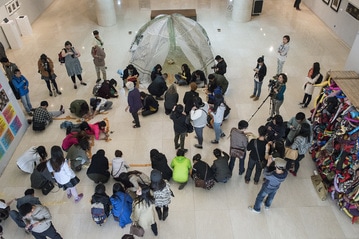 Photo by Christine Giancola
Photo by Christine Giancola
JOURNEY MARKERS
Sherri Cornett and Sandra Mueller
Participants were asked to write onto silk strips of fabric, their name, where they come from and how they “hold up the sky/support their community” and place these in the center of the Points of Many Connections dome created by Cornett and Mueller. Many female Chinese participants expressed that they had rarely or never had the opportunity to stand up and make declarative statements about themselves as invididuals.
Sherri Cornett and Sandra Mueller
Participants were asked to write onto silk strips of fabric, their name, where they come from and how they “hold up the sky/support their community” and place these in the center of the Points of Many Connections dome created by Cornett and Mueller. Many female Chinese participants expressed that they had rarely or never had the opportunity to stand up and make declarative statements about themselves as invididuals.
 Photo by Christine Giancola
Photo by Christine Giancola
PEOPLE’S MICROPHONE SESSION
Elana Mann and Audrey Chan
Elana Mann, with translations by Jing Deng, led a bi-lingual (English and Mandarin) call-and-response People's Microphone session based on their Myths of Rape (2012) performance to bring awareness to issues around rape and sexual assault. The myths and facts about rape address commonly held preconceptions and misconceptions about rape in the context of society, relationships, and global conflicts. Chinese participants were initially very hesitant to repeat the statements. Later we heard that many had never discussed rape, much less said the word rape, but that this experience might make it easier to do so.
Elana Mann and Audrey Chan
Elana Mann, with translations by Jing Deng, led a bi-lingual (English and Mandarin) call-and-response People's Microphone session based on their Myths of Rape (2012) performance to bring awareness to issues around rape and sexual assault. The myths and facts about rape address commonly held preconceptions and misconceptions about rape in the context of society, relationships, and global conflicts. Chinese participants were initially very hesitant to repeat the statements. Later we heard that many had never discussed rape, much less said the word rape, but that this experience might make it easier to do so.
 Photo by Christine Giancola
Photo by Christine Giancola
THESE WALLS CAN TALK PRESENTATION
S.A. Bachman and Neda Moridpour
Women are more likely to be brutalized or die from male violence than from cancer, accidents, and war combined. LOUDER THAN WORDS’ installation addresses domes- tic abuse and alludes to domestic space by the juxtaposition of wallpaper, photographs, and a TV screen. The wallpaper design incorporates a number of common objects that are frequently used to inflict injury: fists, knives, belts and more. Conversely, the TV presents men reciting Jackson Katz’s "10 Things Men Can Do To Prevent Gender Violence". Neda Moridpour discussed these issues, with translations by Jing Deng, and asked participants to place stickers on the wall paper that said, in English and Mandarin, “Don’t Remain Silent.” As with the People's Microphone Session on the Myths & Facts of Rape, Chinese participants told us that they had little experience discussion domestic violence and that services for victims few. A male student broadened the discussion to include questions of how domestic violence affects boys.
S.A. Bachman and Neda Moridpour
Women are more likely to be brutalized or die from male violence than from cancer, accidents, and war combined. LOUDER THAN WORDS’ installation addresses domes- tic abuse and alludes to domestic space by the juxtaposition of wallpaper, photographs, and a TV screen. The wallpaper design incorporates a number of common objects that are frequently used to inflict injury: fists, knives, belts and more. Conversely, the TV presents men reciting Jackson Katz’s "10 Things Men Can Do To Prevent Gender Violence". Neda Moridpour discussed these issues, with translations by Jing Deng, and asked participants to place stickers on the wall paper that said, in English and Mandarin, “Don’t Remain Silent.” As with the People's Microphone Session on the Myths & Facts of Rape, Chinese participants told us that they had little experience discussion domestic violence and that services for victims few. A male student broadened the discussion to include questions of how domestic violence affects boys.
|
ARTISTS ROUNDTABLE
Facilitated by Gallery Director Wang Yi Gang and a translator, U.S. and Chinese artists shared perspectives about art, their lives as women artists and the living in the world as a woman. Initially, the Chinese artists expressed curiosity about why so many US artists focused their work on social justice issues, particularly feminist ones. Living in a country that considers all citizens equal, they did not consider inequality as much of issue. As our discussion progressed, participants were able to see their lives through the lens of the artists from both countries |
|
OPENING CEREMONY
Remarks by Gallery Director Wang Yi Gang
Your browser does not support viewing this document. Click here to download the document.
|
Sample Responses from Chinese Participants
- Wang Yi Gang (Gallery Director): I saw the extraordinary creativity, expressiveness and cohesiveness from the American women artists.
- Cai Shi Di (Artist/Teacher): American artist friends are concentrated in social issues and I was impressed b it. Their work is serious, the issues they concentrated on were full of love, yet their creative expressions were logical. WCA's artists were passionate in interaction with Chinese artists. They intersection through different ethnicity, languages and cultural contexts produced earlier communication between us than would have otherwise been. I admired their professional process and attitude. This has been what I want to bring to my students, and wish my students can create works through this model.
- Fu Qun (art student): Chinese girls can be shy about their thoughts. Sometimes they do have the courage to introduce themselves to others, to tell others what they have done. But these activities give girls a stage to express themselves with more confidence. It changed the way we fell and made us realize that we like to think this way and we like to express ourselves. It can change the quality of our lives. I have never had an experience like this.
- Xu Dan (artist): There are two things that impressed me. First, how independent, anti-violence, and anti-rape they were. As a group, they reflect strong women’s independence and confidence by reading women’s body differently. Second, their art is a more sensitive visual presentation than a man’s. This exhibition clarified and strengthened feminist ideas and philosophy.
- Ke Jia Shan (staff): Before this exhibition, there was little performance [socially-engaged work] on campus. Afterwards, students are creating multiple, interactive projects.... The ideas [the U.S. artists] presented and how they behaved is still touching me. It helps me present my own thoughts now more boldly and directly.
- Song Zoran (artist): The American artists are more direct, sharp and free. And that is what we are missing.
- Yan Si Wen (artist): Maybe in China we do not have a voice to directly express our thoughts... about rape...But through this exhibition, I might be able to push myself to speak out about this topic.
- Fu Qun (art student): Chinese girls can be shy about their thoughts. Sometimes they do have the courage to introduce themselves to others, to tell others what they have done. But these activities give girls a stage to express themselves with more confidence. It changed the way we fell and made us realize that we like to think this way and we like to express ourselves. It can change the quality of our lives. I have never had an experience like this.
Half the Sky: Intersections in Social Practice Art Catalog
Editor: Sherri Cornett
Statement of the Director
Editor: Sherri Cornett
Statement of the Director
Exhibition
The variety of opportunities for artists and the variety of offerings by artists in this project was rich, thought-provoking, innovative and impressive. Alma Ruiz, Senior Curator at the Museum of Contemporary Art in Los Angeles, viewed much of this variety and narrowed her selections to thirty pieces from the U.S. based artists that were displayed at the LuXun Academy of Fine Arts Gallery with Chinese women artists curated by Gallery Director and Curator Wang Yi Gang and Co-curator Zhao Yin Ou. Artists also facilitated interactive pieces and installations that enabled our WCA delegate artists and our Chi nese hosts to cross cultural and language barriers in order to build community and understanding. Each of our WCA delegates had the option to provide additional art and a statement about their connection to this project for inclusion in a section of the gallery and catalog dedicated to the cultural exchange.
Juror and Curators
Prompt for Juried U.S. Art
Almost a half-century ago, Chairman Mao Zedong, who famously said “Women hold up half the sky,” believed women’s active participation in reform would solve China’s economic and societal challenges. More recently, women and men leaders across the world are calling for women’s voices to be heard in all decision making. The theme is now a movement, a documentary, a musical recording. Michelle Bachelet, head of UN Women, opened the UN Commission on the Status of Women 2013 conference by extolling the benefits of being 53% of the world’s population. Women do not need permission, they simply need to speak and act.
Artists were encouraged to interpret this theme broadly. What does it mean to be the majority of the world’s population? What must women do to hold up their “half”? How do women from different cultures interpret this responsibility, this call to action? How do we encourage and support each other through art?
Prompt for Juried Essays
Are there any remaining and defining boundaries to women's art practices and how does this relate to a definition of art as a whole? Are there still niches of art practice particular to a woman's perspective? What are the roots of Social Practice Art in relation to women's art history? How are Social Practice Art academic programs shaping the work of women artists? This art and cultural exchange project with its opportunities for building community and common understanding, collaborative art creation, and dialogue is, in itself, a piece of Social Practice Art. How are such works critiqued? How do we put Social Practice works in context with other art forms? Which women artists in the United States are creating excitement in today’s art marketplace and/or influencing art practices? Essayists are also invited to submit essays about their collaborations with community organizations and other aritsts as well as their relationship to aesthetics, documentation practices and social interventions.
Press and BlogsFacebook Page for Half the Sky: Intersections in Social Practice Art.
https://www.facebook.com/HalftheSkyIntersectionsofSocialPracticeArt?ref=hl The Body Impolitic Blog http://laurietobyedison.com/discuss/2014/04/chineseus-feminist-exhibition-in-china/ Tao Kung Pao newspaper, page A16 http://news.takungpao.com.hk/paper/20140419.html?A16 http://paper.takungpao.com/resfile/PDF/20140419/PDF/a16_screen.pdf http://news.takungpao.com.hk/paper/q/2014/0419/2431796.html |
PanelsOpen Engagement Conference
Pittsburgh, PA April 18, 2015 Panel: “Considerations and Challenges: Socially-Engaged Art in China” Sherri Cornett (Panel Chair), Christine Giancola, Mido Lee, Rosemary Meza-DesPlas, Priscilla Otani Conference2:30-4:00 pm, Room 307, College of Fine Arts, Carnegie Mellon University, Pittsburgh Blog |
Women's Caucus for Art and its International Caucus
The Women’s Caucus for Art (WCA), founded in 1972, is a non-profit, UN-Affiliated NGO and national membership organization whose mission is to expand opportunities and recognition for women in the arts. Its internal International Caucus, which is directing this project, is the liaison between the Women's Caucus for Art's and the United Nations, develops art platforms to support UN Goals, and develops collaborative projects, such as this one, with other global organizations. WCA currently has over 1200 members - both national and international.
WCA’s International Caucus has created art opportunities at international venues since 1995, when it sent a delegation of 100 Women’s Caucus of Arts members to the United Nations 4th World Conference for Women, which was held in several cities in China. More recently these projects have included exhibitions for UN DPI/NGO Conferences and, last year, a collaborative exhibition of South Korean and US artists titled Woman + Body was held in Seoul and Gwangju, South Korea. For more information about WCA’s International Caucus, see: http://wcainternationalcaucus.weebly.com For more information about the South Korean collaboration Woman + Body, see: http://wcainternationalcaucus.weebly.com/women--body-2012south-korea.html |
|
Official Invitation from LuXun Academy to WCA to create Half the Sky: Intersections in Social Practice Art (in Mandarin & English)
|


